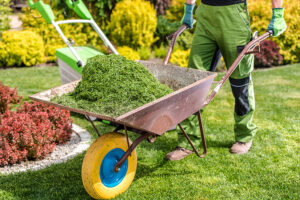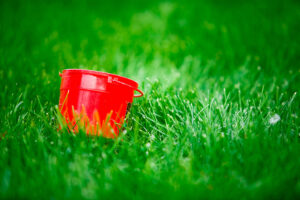A well-fed lawn is what separates the manicured masterpiece from the overgrown jungle.
At the heart of that verdant success is proper fertilization, and key to this is the spreader settings accurate application of fertilizer.
Andersons Lawn Fertilizer Spreader, the unsung hero of your lawn care arsenal, requires just a bit of know-how to become a precision instrument in nourishing your green expanse choreography.
In this comprehensive guide, discover the meticulous settings and adjustments required for the Andersons Spreader to transform your lawn from so-so to showstopper.
Table of Contents
Unveiling The Andersons Lawn Fertilizer Spreader
Before you can ace the settings, you must know your main tool – the Andersons Spreader.
From size to capacity and wheel type to hopper design, understanding the layout of your spreader is like learning the keys to a smooth dance – you’ve got to know where to step.
A Sturdy Companion
The Andersons Spreader is well-recognized for its robust build and user-friendly design.
Engineered to withstand the wear and tear of seasonal use, this spreader promises reliability through many fertilizing sessions.
Components that Matter
The pivotal components include the hopper, the impeller with its setting control, and the handle with variable speed control.
It’s these parts that, when understood and managed efficiently, will deliver an optimal distribution of nutrients across your lawn.
Setting the Spread Rate for Success
The spread rate is the soul of the spreader – get this wrong, and you’ll have patchy results. Get it right, and you’re well on your way to a lawn that’s the talk of the neighborhood.
The Need for Accuracy
Why is getting the spread rate so important? Well, it’s all about making sure each part of the lawn gets its fair share.
You don’t want to underfeed or create a hotspot of fertility; such missteps can lead to uneven growth and the development of strange patterns in your lawn.
Factors at Play
The spread rate isn’t a fixed number; it varies according to the granule size, bulk density, and even the humidity in the air. It’s essential to take these into account to maintain accuracy.
A Step-by-Step Approach
In five definitive steps, ensure your spread rate is spot on for the Andersons model:
- The Setting Levers: Understand how the setting control works. This number is your spread rate meter – higher numbers mean more spread, for faster walking!
- The Test Pass: Before you start, run a test pass in a 100-square-foot area using a known amount of the feed.
- Observation: Walk at a normal pace, letting the spreader do the work. Observe if the spread was uniform or clumped.
- Adjustment: Based on the test results, fine-tune the setting control to either increase or reduce the output.
- Repeat and Review: Always retest after making adjustments until you have a consistent, even spread.
Coverage Adjustments Made Simple
Your yard isn’t just one big green canvas – it houses flower beds, trees, and clusters of shrubs. Each area requires a different amount of fertilizer.
The spreader needs to be as adaptable as the environment it serves.
Calculating for Precision
Use a yardstick, a square yard, and some precision math to determine how much spread per area is needed.
This will allow for precise adjustments when you move from one section to another.
Versatility in Action
Adjust the spreader controls to match the calculated amount for the given area.
A larger area would need the spreader on a higher setting for more fertilizer, while a smaller space requires a lower setting to avoid waste.
Maintaining Your Precision Spreader
The relationship with your spreader isn’t a one-time affair.
Regular care and maintenance will keep your Andersons Spreader reliable and precise for years to come.
Post-Use Rituals
After each use, clean the hopper and impeller. Any leftover fertilizer can corrode the metal parts, leading to premature wear and tear.
The Power of Storage
For the off-season, store your spreader in a dry place, away from moisture. A quick lubrication of the moving parts will keep them from rusting.
Preparing for Duty
Before the next use, always give your spreader a once-over. Check for any damage, loose screws, and ensure the wheels turn smoothly.
Troubleshooting The Hiccups
Even the most meticulous spreader owners can run into problems. Recognizing common issues and how to tackle them is critical in maintaining your lawn’s health.
Jammed in the Hopper
If the impeller isn’t turning, you might have a jam in the hopper. Remove any clumps before they harden. Prevention is better than cure, in this case.
Uneven Spread
For those pesky patterns that appear no matter how careful you are, uneven spread might be the culprit. Regular calibration checks can help manage this.
Stuck in Speed
If the handle has become difficult to turn, it might be due to dirt and debris. A thorough cleaning can often fix this issue. Just be sure to lubricate the handle afterward.
Conclusion – The Lawn Revival
The Andersons Lawn Fertilizer Spreader may look like just another piece of lawn care equipment, but once you master its settings and learn to listen to its spread, you’re on the cusp of lawn care success.
With patience and practice, you can transform every yard into a thriving canvas of green vitality.
Setting your Andersons Spreader isn’t just about distributing feed; it’s about understanding your own lawn care habits.
The settings are your personal signature on the landscape, a promise of the meticulous care that shines through in your yard’s health and beauty.



